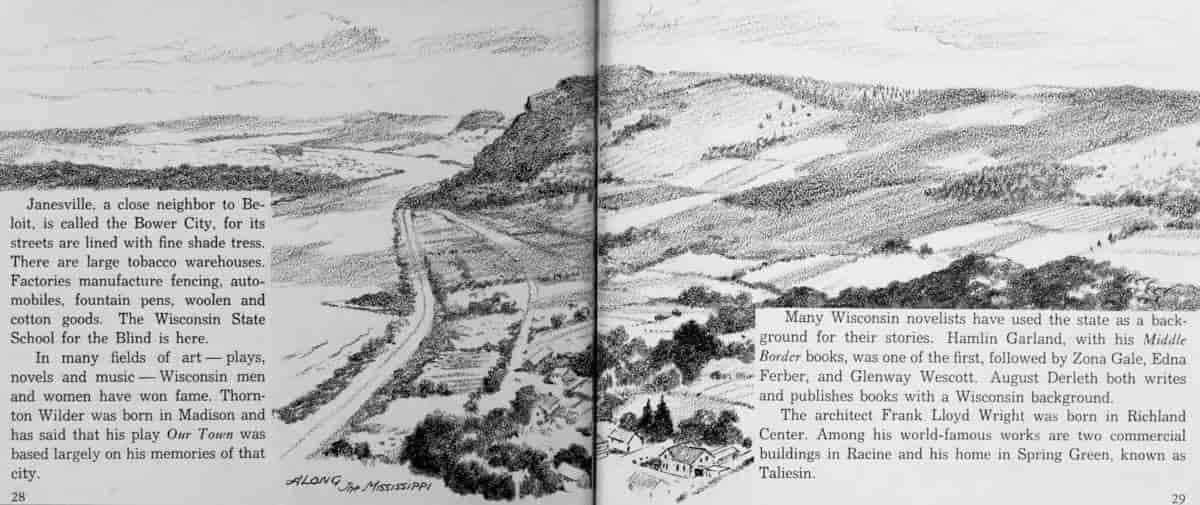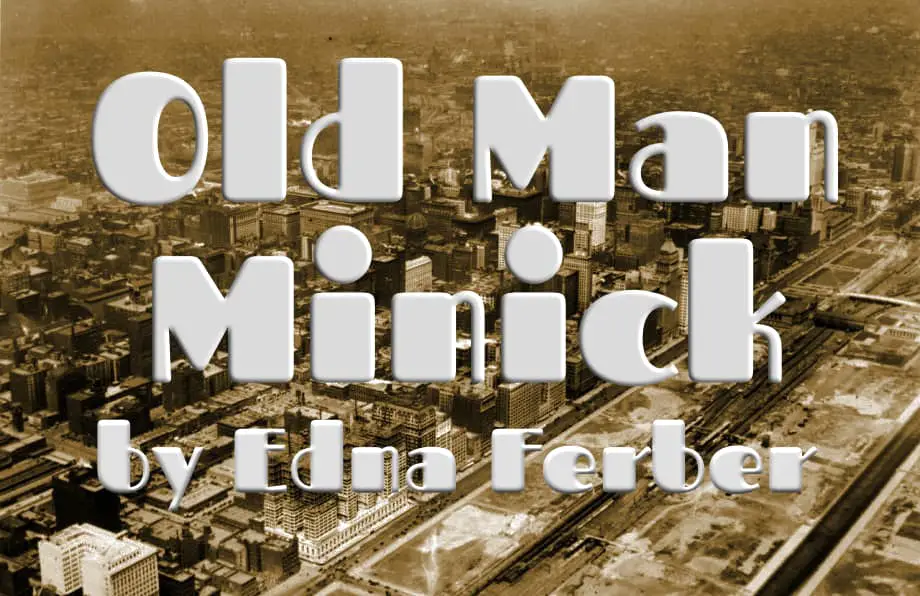“Old Man Minick” is a short story by Edna Ferber, published 1922. A widower learns how to live contentedly after his wife dies unexpectedly before he does.

WHAT HAPPENS IN “OLD MAN MINICK”
Set in Chicago in the early 20th century, nearish the union stock yards, which were infamous for their stink. There’s mention of a stock market crash, which I think would be the one in 1914 (preceding The Great Depression and coinciding with WW1). This is an era when women did everything for men, including making their beds.
Old Man Minick opens with a detail which summarises the nature of the relationship between an old married couple of 40 years: The husband thinks he needs two pillows, his wife provides it, and every single night he throws the pillow off the bed. Every single morning the wife puts it back.
Old Man Minick is frightened of night vapours but Ma Minick overrides him and they sleep with the window open.
Ma Minick dies, which blindsides Old Man Minick, because you rarely see widowers — only widows. It is decided that he’ll live with his son and daughter-in-law. He occupies a bedroom off the kitchen. He makes a bit of a nuisance of himself, visiting his son at work when everybody’s busy. He makes friends with the women help, and the seamstress tries to persuade him to marry her. He rebuffs her advances, thinking it ridiculous.
Nettie, his daughter-in-law won’t let him have two pillows, since it’s her who’s expected to make his bed and she gets real sick real quick of picking up that second pillow off the floor.
Old Man Minick’s life improves when he discovers the locus of all the other old widowers — at a Club on Washington Park. He divides them into two main types — those who live with a child and those who live in aged care. Each group has convinced themselves his choice is better than the other.
The mindless conversation feels like ‘oral death’ to Old Man Minick. Mostly it’s phatic communion. But even when there’s a meaty conversation, winning his point seems to have no point.
Edna Ferber makes use of the Symbolism of Seasons, and Old Man Minick dreads the coming winter. (Winter = death.)
One day he returns to his daughter-in-law’s house (to which he’s never been given his own key) and overhears her talking to her friends. She’s saying she can’t have a child so long as she has her father-in-law to look after, with him occupying the spare room. Old Man Minick creeps out, pretending he hasn’t heard. But he does tell Nettie he’s moving in to the old people’s home. Nettie realises he’s overheard her.
At the old people’s home he enjoys his life, in which he actually has more freedom, because he’s paid someone to allow him to have two pillows.
CHARACTERS IN “OLD MAN MINICK”
Ma Minick — In contrast to her husband she is practical. 66 years old.
Old Man (Jo) Minick — 70 years old. he thinks of himself as modern but is mistrustful of ‘miasmas’ in the night air. Once upon a time this was a legitimate fear… in the Middle Ages through to Early Modern England. Noxious fumes were widely thought to descend from the sky. “Night fogges” and “noysom vapours”. You’ll find this idea in Shakespeare — “the daylight sick”. “Make haste, the vaporous night approaches.”
George — Their son, probably a real estate agent or similar. Lived at home until he was 36.
Nettie — George’s wife. They married late. ‘A plump, handsome, eye-glassed woman with fine fresh colouring, a clear skin that old man Minick called appetizing, and a great coil of smooth dark hair. She wore plain tailored things and understood the bond business in a way that[Pg 42] might have led you to think hers a masculine mind if she hadn’t been so feminine, too, in her manner. Old man Minick had liked her better than Ma Minick had.’
Alma — Their married daughter who lives in Seattle. Her husband’s nickname is Ferd. Married young.
Paul — Another son, but died at 13. Paul is probably the reason why Mr and Mrs Minick never talked about death between them.
Canary The Negro Washwoman — eats lunch with Jo Minick once a week. a rich throaty voice, a rolling eye, and a kindly heart.
Sewing woman — hired for several weeks per year. Becomes great friends with Old Man Minick. Then she comes onto him. She is compared to a hawk. As a consequence, we are to understand that she is interested in him for his modest amount of money.
STORY STRUCTURE OF “OLD MAN MINICK
SHORTCOMING
Ferber makes a good job of painting a character who is at once sympathetic and irritating. I can see exactly why Nettie wouldn’t enjoy picking his pillow up off the floor — she never asked to have her father-in-law move in with them. She probably expected it would be Mrs Minick, if either of them. Mrs Minick would’ve made her own bed, but since it’s the man, she’s expected to make his bed.
And Old Man Minick’s moral shortcoming is that he likes things just so.
DESIRE
He doesn’t really like sleeping with two pillows — he likes the fact that someone else is allowing him to have them, and is picking them up after him each morning. To use modern lingo, that’s his ‘love language’, as annoying, patriarchal and minimising as that actually feels to anyone other than his wife, who saw many other parts of him and therefore put up with it.
The pillow therefore stands in for an aspect of Old Man Minick’s psychology.
OPPONENT
His opponent is Nettie, since he can’t feel at home in her house — for many small reasons. He focuses on the pillow which she won’t let him have, though it’s eventually revealed she hasn’t given him a house key, which you’d think is a greater imprisonment.
His romantic opponent is the unnamed seamstress, who he knows is hoping to make an arrangement in which she gives him homely services and he provides her with a comfortable income. He sees through this.
PLAN
This is an example of a story in which the main character has no strong plan — a grieving man is reactive. But eventually, as he comes out of his intense grief, he joins the Club and meets other old men.
His final plan is made on the spur of the moment, between eavesdropping and reentering through the front.
BIG STRUGGLE
The Battle scene is when Old Man Minick returns ‘home’ to overhear his daughter-in-law saying that she can’t have a child until he moves out.
ANAGNORISIS
He realises that living at the old people’s home affords him more freedom, despite the inane conversations and being surrounded by fellow septuagenarians. This anagnorisis is prompted by the old man who tells him that he’s never been so lonely than when living with his own family and five grandchildren in their big, noisy house.
Does he realise that the old must move over in order to make way for the young? All the way through, I got the impression Nettie doesn’t want children. She’s using the father-in-law as a reason not to have any, in an era when women need a good reason.
NEW SITUATION
The New Situation phase of this story is broken off into its own section. For Old Man Minick, this marks a completely separate phase of his elderly life. He now lives at the old folks’ home, where he can feel like the boss due to his paying people to do menial things for him, such as pick his pillow off the floor each morning.

